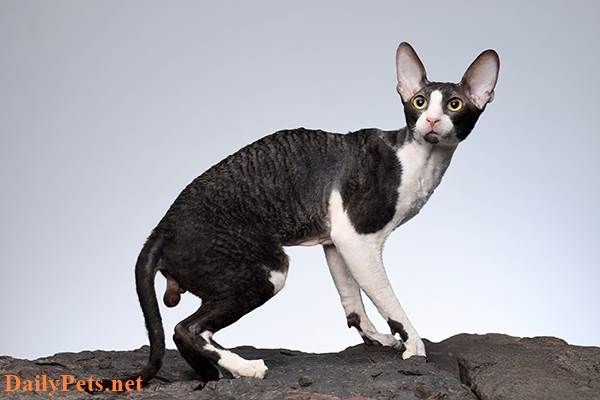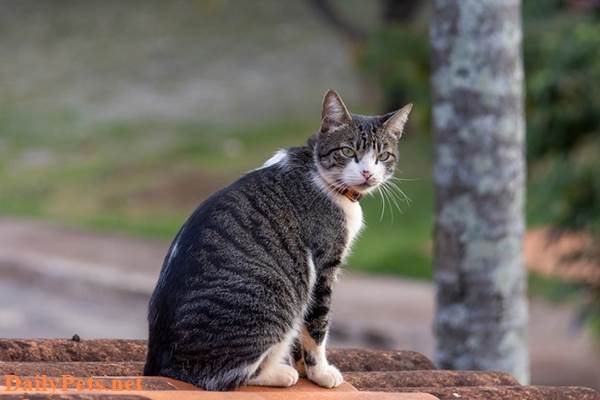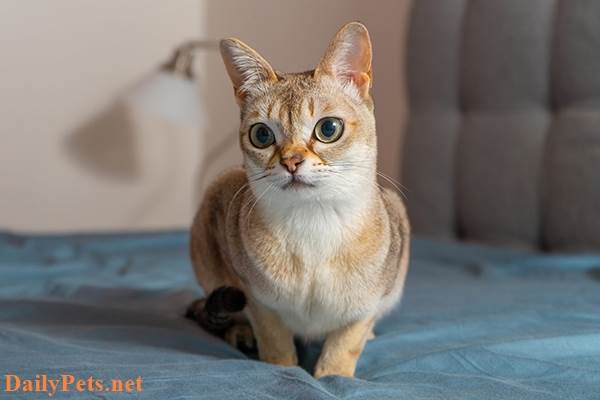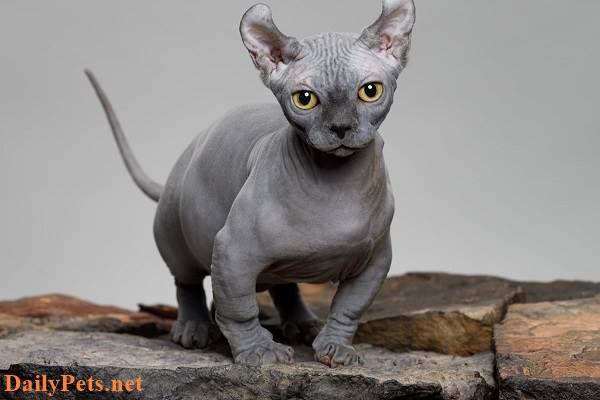Cornish Rex cats are also known for their playful and affectionate personalities. Join Dailypets.net to learn more details through this article.
The Origin and History of the Cornish Rex Cat
Cornish Rex is a cat breed originating from England. They have an interesting story in Bodmin Moor, Cornwall, in 1950. A cat named Serena gave birth to a litter of five kittens. There is only one white male cat with unusual curly fur among them. Then, people named it Kallibunker (Kalli), and it became the first Cornish Rex cat breed.

Cornish Rex Cat.
Due to the small and rare genetic resources, the Cornish Rex cat was once in danger of extinction. In 1960, researchers bred this cat breed with domestic cats such as the Siamese cat, Russian Blue cat, American Shorthair cat, British Shorthair cat, and Havana Brown cat.
The Cornish Rex breed was first recognized by the Cat Fancy in the UK in 1955 and by the CFA in the US in 1959.
The Cornish Rex cat breed is quite popular in England and the United States, and breeders began to cross them with other breeds to create new breeds with similar coats. These include the Devon Rex and the German Rex.
Today, the Cornish Rex is still a popular cat breed worldwide. Although they are still relatively rare compared to other cat breeds, their unique appearance and personality make them popular with many people.
Physical characteristics of the Cornish Rex cat
Cornish Rex cats have many different physical characteristics than other cat breeds. They have lean, muscular bodies, long legs, and narrow chests. The Cornish Rexc is medium-sized, weighing from 3kg to 5kg.

One of the most striking physical features of the Cornish Rex is its short, soft, curly coat. Unlike other cats with an undercoat and an undercoat, the Cornish Rex has only one coat of curly hair. This unique undercoat texture gives them a distinctive look and smooth feel to the touch. The coat comes in various colors and patterns, including monochromatic, tortoiseshell, and tabby.
The Cornish Rex has large ears that stand high on the head and have a distinctive curl at the tip. They have oval heads with a slightly sloping nose and high cheekbones, giving them a somewhat elf-like appearance. Their eyes are large and oval, with colors ranging from green, yellow, and copper to blue.
The Cornish Rex cats also have elongated legs with small oval feet. They have a long, tapered tail at the end and are often raised high in the air. Their bodies are well-proportioned, toned, and muscular, making them agile and nimble.
Personality traits of Cornish Rex cats
One of the Cornish Rex’s most notable personality traits is its intelligence. These cats are curious, have a knack for problem-solving, and a desire to explore their surroundings. Cornish Rex cats are known to be especially easy to train, often learning tricks and behaviors that other cats may have difficulty with.
Another outstanding feature is its emotional nature. Cornish Rex cats love being close to their owners and often cling to them like glue. They make loud purring sounds and want to snuggle in their owner’s lap for hours.
Despite its affectionate nature, the Cornish Rex cat is also quite independent. If the owner is too busy, they can play alone or lie in a corner waiting for their owner. They will not be too clingy but will appreciate the care and affection of their owners.
In addition, the Cornish Rex is also a cat breed that is full of energy and loves to play, often playing for hours. They will mess with toys or objects in the house, so you should also keep an eye on them.
The Cornish Rex is an intelligent, affectionate, independent, and playful cat breed. Whether curled up in their lap or chasing toys, these cats will win the hearts of anyone lucky enough to become their owner.
Some health problems in Cornish Rex cats
Like many other cats, the Cornish Rex can be susceptible to certain health problems. Here are some of the most common health problems that can affect them:
- Hypertrophic cardiomyopathy (HCM): This is a genetic heart disease common in many breeds of cats, including the Cornish Rex. HCM can cause heart muscle thickening, leading to heart failure or sudden death.
- Patellar luxation: This is a condition in which the kneecap slips out of place, causing lameness or difficulty walking. Cornish Rex cats may be susceptible to this condition due to their long, slender legs.
Gastrointestinal problems: Cats can be susceptible to gastrointestinal problems such as inflammatory bowel disease (IBD) and gastroenteritis. These conditions can cause symptoms such as vomiting, diarrhea, and weight loss. - Skin Problems: Cornish Rex cats can be prone to skin problems such as dermatitis and allergies because of their short and very fine coat. These conditions can cause itching, redness, and skin irritation.
- Respiratory problems: They may be susceptible to upper respiratory infections, which can cause symptoms such as sneezing, coughing, and runny nose.
If you are considering adopting a Cornish Rex cat, choosing a reputable breeder who screens the cat for genetic health problems is important. Also, it’s important that you take your cat to the vet for routine checkups and to seek veterinary care if you notice any signs of illness or health problems.
How to care for a Cornish Rex Cat
Cornish Rex cat food
The main food of Cornish Rex cats is wet and dry. This breed of cat has a quite sensitive digestive system. Therefore, you need to adjust the amount of dry food to no more than 1/6 of your cat’s total daily food amount.
In particular, you should add water to increase your cat’s resistance. Eating natural foods, you should prepare according to a diet of 20% vegetables, cereals, yogurt, 80% fish, chicken breast, beef, etc…
Cornish Rex Cat nutrition by stage
The stage for Cornish Rex kittens is from birth to 12 months old
The cat’s digestive system is not yet complete in the first months of life. Therefore, you need to take good care to avoid cat diarrhea. Kittens under 1-year-old should be fed with breast milk or specialized formula.
At the age of 4 – 5 weeks, start training your Cornish Rex cat to eat. You can divide meals into smaller portions and feed your cat 5-6 times daily. Fresh foods with high water content are great choices during this period.
The stage for adult Cornish Rex cats
When mature, the Cornish Rex cat’s body fully completes the required functions. You can decide their daily diet based on your cat’s weight, health, and activity level.
An adult average-weight cat will need about 250 calories/day to maintain health. Note you should still add enough water because they drink very little water.
How to care and hygiene for a Cornish Rex Cat
Cornish Rex cats are adaptable if you give them enough love and care for their needs. The best thing about this cat breed is that they shed very little hair. Therefore, you need to gently stroke your cat’s fur with your hand to remove dead hairs.
Only bathe your cat when it is too dirty or smelly, and brush their teeth once a week. At the same time, you should regularly clean your cat’s eyes with a soft, damp cloth. You can use cotton wool or a damp cloth for Cornish Rex cat ears. In addition, make sure your place has a stable temperature to prevent your cat from getting sick.
Health problems common to Cornish Rex cats
Although the Cornish Rex cat breed is strong, it still has some health issues to note, as follows:
- Insufficient hair disease: People call it genetic baldness because some cats have thinner and sparser coats than others.
- Umbilical hernia: Occurs when there is a malformation in the cat’s abdominal wall near the navel, called umbilical hernia.
- Hypertrophic cardiomyopathy: Heart disease is found in some breeds of cats.
- The Cornish Rex cat’s coat is weak: You should avoid letting your cat sunbathe in the yard because it will make the cat’s skin uncomfortable or cause its fur to not grow as normal.
Notes when taking care of Cornish Rex Cats
The Cornish Rex cat is active and loves to play, chase, and even learn small tricks. Therefore, you should carefully study these characteristics to behave appropriately with them.
On the other hand, when you bring your Cornish Rex cat to adopt, you need to take them to a veterinarian and receive certain vaccinations such as Rabies Vaccine, Leukopenia Vaccine, Nasopharyngitis – Tracheitis Vaccine Infectious diseases, and vaccines to prevent diseases caused by Herpesvirus.
In addition, you can consider injecting Cornish Rex cats with some other drugs depending on the lifestyle, age, environment, etc… Clean water ensures the cat’s body develops stably. The Cornish Rex cat’s diet should be full of protein, calcium, fat, vitamins, etc., to improve the cat’s immune system.
Cornish Rex price
According to surveys, the average price of a Cornish Rex kitten can range from $800 – $2,000 or more. Depending on factors including age, pedigree, coat color, and purity, the cost of ownership will vary greatly.
The Cornish Rex cat breed is quite expensive and rare. Therefore, you should buy from a reputable place to be assured of their pedigree, purity, and health. Not only does the initial purchase cost, but you also incur many other fees, including care, food, medical examination, toys, snacks,…





